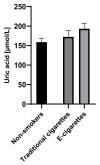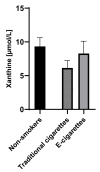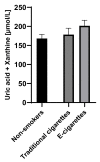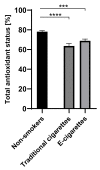Influence of Electronic Cigarettes on Antioxidant Capacity and Nucleotide Metabolites in Saliva
- PMID: 34678959
- PMCID: PMC8538442
- DOI: 10.3390/toxics9100263
Influence of Electronic Cigarettes on Antioxidant Capacity and Nucleotide Metabolites in Saliva
Abstract
The balance between reactive oxygen species production and the activity of antioxidant systems present in saliva is an important element in maintaining oral environment homeostasis. E-cigarettes adversely affect the oral cavity and their cytotoxic effect is related to oxidative stress. The aim of this study was to assess the influence of using electronic cigarettes on antioxidant capacity of saliva. The study involved 110 subjects (35 e-cigarettes users, 33 traditional cigarettes smokers and 42 non-smokers). Laboratory analysis involved quantitation of uric acid, hypoxanthine, xanthine, TAOS (total antioxidant status) and TEAC (Trolox equivalent antioxidant capacity) in saliva. Lower values for TAOS and TEAC were observed among e-cigarettes users and traditional cigarettes smokers in comparison to non-smokers. Uric acid concentration tended to be higher among e-cigarettes users while no differences in hypoxanthine and xanthine saliva concentrations were observed. Electronic cigarettes usage affects antioxidant capacity of saliva to the same extent as traditional cigarettes, when comparing smokers to non-smokers. Further longitudinal studies on a larger study group are needed to assess the effect of changes in antioxidant status on oral health.
Keywords: antioxidant capacity; e-cigarettes; saliva; uric acid.
Conflict of interest statement
The authors declare no conflict of interest.
Figures










Similar articles
-
Influence of Electronic Cigarettes on Selected Physicochemical Properties of Saliva.Int J Environ Res Public Health. 2022 Mar 11;19(6):3314. doi: 10.3390/ijerph19063314. Int J Environ Res Public Health. 2022. PMID: 35329001 Free PMC article.
-
Effect of smoking one cigarette on antioxidant metabolites in the saliva of healthy smokers.Arch Oral Biol. 1999 Jun;44(6):485-8. doi: 10.1016/s0003-9969(99)00025-4. Arch Oral Biol. 1999. PMID: 10401526
-
A pilot investigation into the influence of electronic cigarettes on oral bacteria.Postepy Dermatol Alergol. 2021 Dec;38(6):1092-1098. doi: 10.5114/ada.2020.100335. Epub 2022 Jan 7. Postepy Dermatol Alergol. 2021. PMID: 35126020 Free PMC article.
-
Comparison of smoking traditional, heat not burn and electronic cigarettes on salivary cytokine, chemokine and growth factor profile in healthy young adults-pilot study.Front Physiol. 2024 Jun 10;15:1404944. doi: 10.3389/fphys.2024.1404944. eCollection 2024. Front Physiol. 2024. PMID: 38915777 Free PMC article.
-
The Relationship Between Salivary Redox, Diet, and Food Flavor Perception.Front Nutr. 2021 Jan 28;7:612735. doi: 10.3389/fnut.2020.612735. eCollection 2020. Front Nutr. 2021. PMID: 33585536 Free PMC article. Review.
Cited by
-
Vitamins C and E alleviate the deleterious effects of electronic cigarettes on tongue muscles and nerves in rat model.BMC Oral Health. 2025 Jul 16;25(1):1184. doi: 10.1186/s12903-025-06523-z. BMC Oral Health. 2025. PMID: 40670937 Free PMC article.
-
Advantages and Disadvantages of Electronic Cigarettes.Toxics. 2023 Jan 11;11(1):66. doi: 10.3390/toxics11010066. Toxics. 2023. PMID: 36668791 Free PMC article.
-
The Impact of E-Cigarettes on Oral Health-A Narrative Review.Dent J (Basel). 2024 Dec 10;12(12):404. doi: 10.3390/dj12120404. Dent J (Basel). 2024. PMID: 39727461 Free PMC article. Review.
-
Halitosis among users of electronic nicotine delivery systems in a multi-center cross-sectional study.Sci Rep. 2025 Jun 25;15(1):20287. doi: 10.1038/s41598-025-05439-6. Sci Rep. 2025. PMID: 40562833 Free PMC article.
-
The Effects of E-Cigarette Aerosol on Oral Cavity Cells and Tissues: A Narrative Review.Toxics. 2022 Feb 6;10(2):74. doi: 10.3390/toxics10020074. Toxics. 2022. PMID: 35202260 Free PMC article. Review.
References
-
- Dyba J., Lenkowski M., Surdacka A. Evaluating the diagnostic potential of saliva in respect of periodontal disease as well as changes occurring within the endothelium. Dent. Forum. 2017;1:21–25.
LinkOut - more resources
Full Text Sources

